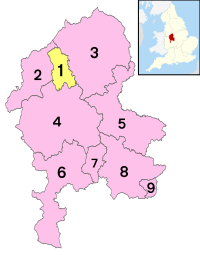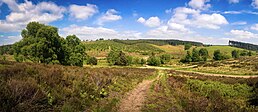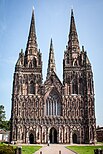
Back Staffordshire Afrikaans ستافوردشاير Arabic Staffordshire AST Staffordshire BAN Стафардшыр Byelorussian Стафардшыр BE-X-OLD Стафордшър Bulgarian Staffordshire Breton Staffordshire Catalan Staffordshire CEB
Staffordshire | |
|---|---|
The Sherbrook Valley in Cannock Chase; a bottle kiln in Longton, Stoke-on-Trent; and Lichfield Cathedral | |
 Staffordshire within England Staffordshire within England | |
| Coordinates: 52°48′25″N 02°06′58″W / 52.80694°N 2.11611°W | |
| Sovereign state | United Kingdom |
| Constituent country | England |
| Region | West Midlands |
| Established | Ancient |
| Time zone | UTC+0 (GMT) |
| • Summer (DST) | UTC+1 (BST) |
| UK Parliament | List of MPs |
| Police | Staffordshire Police |
| Ceremonial county | |
| Lord Lieutenant | Ian Dudson |
| High Sheriff | Charles Jewitt of Admaston[1] (2020–21) |
| Area | 2,714 km2 (1,048 sq mi) |
| • Rank | 18th of 48 |
| Population (2022)[2] | 1,146,249 |
| • Rank | 16th of 48 |
| Density | 422/km2 (1,090/sq mi) |
| Ethnicity |
|
| Non-metropolitan county | |
| County council | Staffordshire County Council |
| Control | Conservative |
| Admin HQ | Stafford |
| Area | 2,620 km2 (1,010 sq mi) |
| • Rank | 11th of 21 |
| Population (2022)[3] | 886,284 |
| • Rank | 9th of 21 |
| Density | 338/km2 (880/sq mi) |
| ISO 3166-2 | GB-STS |
| GSS code | E10000028 |
| ITL | UKG24 |
| Website | staffordshire |
| Districts | |
 Districts of Staffordshire Unitary County council area | |
| Districts | |
Staffordshire (/ˈstæfərdʃɪər, -ʃər/;[4] postal abbreviation Staffs.) is a landlocked ceremonial county in the West Midlands of England. It borders Cheshire to the north-west, Derbyshire and Leicestershire to the east, Warwickshire to the south-east, the West Midlands county and Worcestershire to the south, and Shropshire to the west. The largest settlement is the city of Stoke-on-Trent, and the county town is Stafford.
The county has an area of 1,713 square kilometres (661 sq mi) and a population of 1,131,052. After Stoke-on-Trent (258,366), the largest settlements are Tamworth (78,646), Newcastle-under-Lyme (75,082), Burton upon Trent (72,299) and Stafford (71,673); the city of Lichfield has a population of 33,816. For local government purposes Staffordshire comprises a non-metropolitan county, with nine districts, and the unitary authority area of Stoke-on-Trent. The county historically included the north-west of the West Midlands county, including Walsall, West Bromwich, and Wolverhampton.
Staffordshire is hilly to the north and south. The southern end of the Pennines is in the north, containing part of the Peak District National Park, while the Cannock Chase AONB and part of the National Forest are in the south. The River Trent and its tributaries drain most of the county. From its source, near Biddulph, the river flows through Staffordshire in a southwesterly direction, meeting the Sow just east of Stafford; it then meets the River Tame and turns north-east, exiting into Derbyshire immediately downstream of Burton upon Trent.
Staffordshire contains a number of Iron Age tumuli and Roman camps, and was settled by the Angles in the sixth century; the oldest Stafford knot, the county's symbol, can be seen on an Anglian cross in the churchyard of Stoke Minster. The county was formed in the early tenth century, when Stafford became the capital of Mercia. The county was relatively settled in the following centuries, and rapidly industrialised during the Industrial Revolution, when the North Staffordshire coalfield was exploited and fuelled the iron and automobilie industries in the south of the county. Pottery is the county's most famous export; a limited amount is still produced in Stoke-on-Trent.
- ^ "No. 62943". The London Gazette. 13 March 2020. p. 5161.
- ^ "Mid-2022 population estimates by Lieutenancy areas (as at 1997) for England and Wales". Office for National Statistics. 24 June 2024. Retrieved 26 June 2024.
- ^ "Mid-Year Population Estimates, UK, June 2022". Office for National Statistics. 26 March 2024. Retrieved 3 May 2024.
- ^ "Staffordshire". Collins Dictionary. n.d. Archived from the original on 3 March 2016. Retrieved 29 May 2020.


